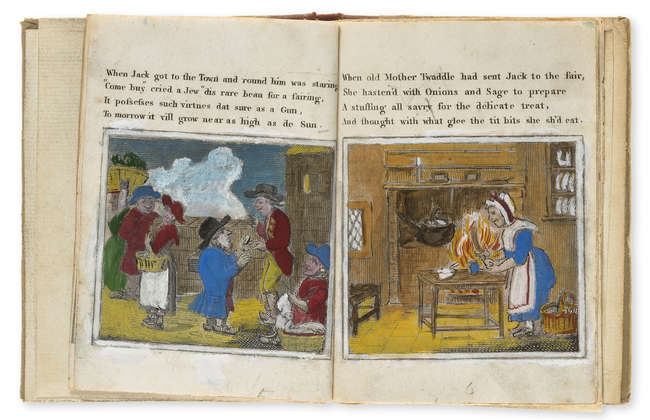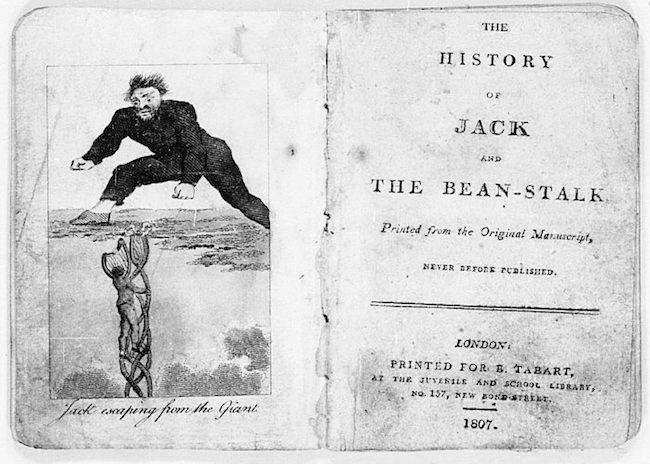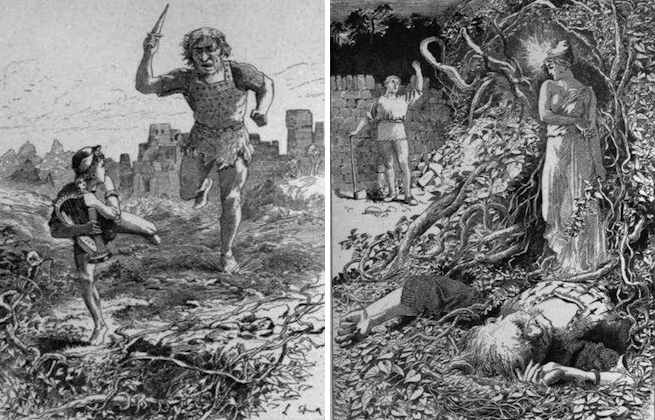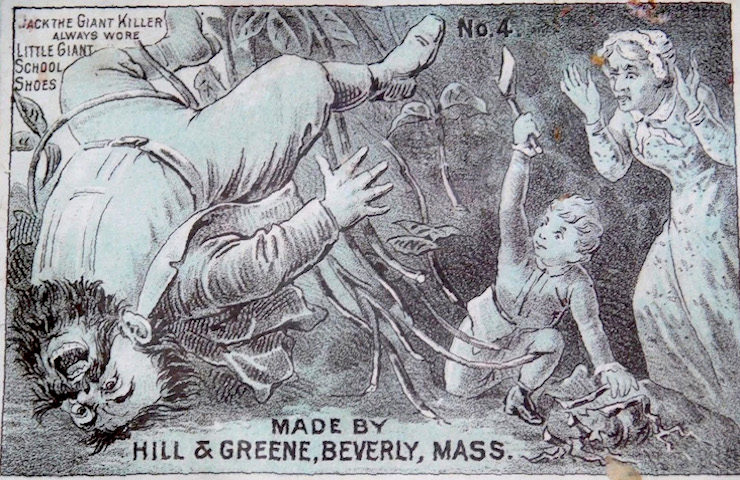Last week, we talked about the first literary version of Jack and the Beanstalk, a weird tale from 1734 framed by discussions of Christmas traditions, witches, hobgoblins and ghosts, that hinted at revolution and overthrow. And pretty much stated flat out, without hinting, that before Jack went up the beanstalk, he was involved in some entertaining bedtime fun with his grandmother, an enchantress, fun that eventually allowed him to become the ruler of an entire world. Ahem.
Perhaps not surprisingly, Jack and the Beanstalk vanished from the literary world for several decades after this—either because few writers felt capable of following this up with their own version, or because few writers wanted to be associated with that version. But in 1807, a certain B.A.T. published a short verse version, The History of Mother Twaddle, and the Marvellous Atchievements of Her Son Jack (the spelling is B.A.T.’s, not mine) which was apparently popular enough to be republished in Pennsylvania two years later by William Charles, who charged 25 cents per copy. (The book did contain 15 engravings.) By short, I mean very short: a surviving copy (which recently sold for $3000) contained only 16 leaves—but was lavishly illustrated in color.

The illustrations, the size of the book, the language level and the rhymes all suggest that unlike its predecessor, The History of Mother Twaddle was meant for children. It starts off simply: Mother Twaddle finds a unexpected sixpence, and sends her son Jack off to get a goose:
For of all the good things, I vow and protest,
A Goose is the nicest, and I love it the best.
Not, perhaps, the best poetry, but something that could easily be read to a child.
Instead of a goose, however, Jack ends up buying a bean from a Jew—a slight touch of antisemitism somewhat mitigated by the fact that this is a magic bean—if a bean that leads Jack straight into the home of a giant, who quotes a rhyme similar to the one in the earlier story:
….Fe, fo, fan,
I smell the blood of an Englishman,
If he be alive, or if he be dead,
I’ll grind his bones to make my bread.
….suggesting that either this author knew the earlier version, or that this poem had been firmly attached to the oral version of the story.
Jack and a maid in the castle quickly convince the giant to drink some ale, which causes the giant to fall down, allowing Jack to cut off the giant’s head. Jack then sends for his mother, they finally have some goose, and Jack realizes that the maid is quite pretty:
The Parson came soon and made her Jacks wife
And they livd very happy to the end of their life.
How exactly everyone convinced the Parson to climb the beanstalk is not quite clear, but maybe they were able to pay him a little extra from the giant’s treasure.
This extremely short version, containing little beyond Jack, the giant, the rhyme and a happy ending (my quotes are about 1/3 of the entire text, no exaggeration), was one of two to appear that year. The second—claiming, inaccurately, to be the first version of the History of Jack and the Beanstalk (publishers: exaggerating since at least 1807) was published by a certain Benjamin Tabart, whose company almost exclusively published children’s stories—both the very didactic (and boring) and stories with—gasp—no moral at all. I know.
As a sidenote, that lack of morals, along with some other evidence, has led some scholars to believe that Benjamin Tabart was not, as it happened, actually Benjamin Tabart, but rather Sir Richard Philips, a known political radical who would not have been the choice of most parents of the era as an instructor for their children, and who therefore would have found it rather difficult to sell children’s books under his own name. This was also almost certainly why The History of Jack and the Beanstalk was published anonymously—because, by most indications, this version was not penned, selected and edited by either Tabart or Philips, but rather by one of the Godwins: political activist, writer and scholar William Godwin (1756-1836) or his second wife, Mary Jane Godwin (?1766—1841), these days best known as the father and stepmother, respectively, of Mary Shelley, author of Frankenstein.
Mary Shelley’s own accomplishments and notoriously exciting life have tended to overshadow the accomplishments of her father and stepmother, and in particular, their role in helping to establish two separate lines of children’s books: the popular Tabart books (where The History of Jack and the Beanstalk first appeared) and their own Juvenile Library. For the most part, their goals tended to be purely monetary: between them, the Godwins were responsible for five children, and they had their own expenses. But they also had a love of fairy tales and literature, which they wanted to spread.
Fortunately for them—and Tabart (or Philips) their fairy tale publications just happened to correspond with a rising interest in fairy tales—which was presumably behind the idea of publishing The History of Jack and the Beanstalk, in an illustrated text that the title page described as suitable for juveniles and schools. The word “History” was given some weight by the decision to set the story in a very specific historic time—the reign of King Alfred (849-899), one of Britain’s more admired kings—though otherwise, this story cannot be considered particularly historical, let alone faithful to the Anglo-Saxon period.

This Jack is a greatly indulged child—an indulgence the author does not admire—to the point where he and his widowed mother are down to their last cow. Faced with the choice of selling the cow or starving, his weeping mother chooses to sell the cow, trusting Jack to be able to do that, at least. Jack instead trades the cow for some colorful beans—infuriating his mother, who kicks the beans around in a fury. Some land in the garden—and by the morning, Jack is shocked to see a giant beanstalk growing in the garden.
Already, a few shifts have entered the story: the cow (new to this version, rapidly becoming a staple of other versions) and Jack not sowing the beans himself. Also, this beanstalk has—helpfully enough—grown into the shape of a ladder, which makes it easier to climb.
At the top of the beanstalk, Jack finds a desert and a fairy, who informs him that his father was an extremely wealthy, benevolent man, murdered by a giant as he was trying to offer the giant a book. I know. Which all probably explains just why Jack was so indulged as a child. The fairy notes that she inspired Jack to trade the cow for the beans, and then, after very kindly giving him the near perfect excuse for that major slipup (“Sure, Mom, we had nothing for dinner, but on the other hand, a fairy made me do it!”) she informs Jack that he is the person appointed to punish the giant for all of his wickedness. She then vanishes without offering him anything to eat, even though just a few pages ago he was dying of hunger and has had nothing to eat since. For stories consumed with the thoughts of beans and food, people really don’t get to eat all that much in the middle of them.
In fact, the first person who offers Jack any real food is the giant’s wife, who feeds him up right before showing him all of the various prisoners living in the giant’s grand house, waiting to be eaten. Then she hides him in the oven, which does not quite seem like the safest hiding place, but moving on. Just in time, since the giant is back, and hungry, and able to smell humans—though first, he needs to get his golden egg from a hen. Jack watches, steals the hen, and hurries home. He and his mother sell off a few golden eggs, which does wonders for their finances. And then Jack decides to head up the beanstalk again. (A footnote explains that he’s afraid that the fairy will come after him if he doesn’t.) Disguising himself, he manages to sweet-talk his way into the giant’s home again, and steal away with a bag of gold and a bag of silver—enough to keep him and his mother well off for three years.
For some reason, nobody—including the giant, who you would think would be a bit concerned about this—has done anything about the beanstalk during this time, making it fairly easy for Jack to climb up the beanstalk again, this time carrying away a self-playing harp. The harp, kinda freaked out by all this, starts screaming, summoning the giant who tears off after Jack, who has the sense to call for a hatchet, and the very good luck to have someone standing nearby who just happens to have a hatchet, like, how many of us, when we really, really need to hit someone or something with an axe, have someone ready and willing to hand one over to us? Outside of hobbits travelling to Mordor, of course, and even then. Jack is one lucky dude, is what I’m saying. Jack slices through the beanstalk, knocking it down and killing the giant.
We never do find out what happened to the castle, or, for that matter, the other humans kept prisoner in the castle. Maybe the giant already ate them. Nor do we find out exactly who just happened to be standing near the bottom of this beanstalk wielding a hatchet. Not Jack’s mother—as the tale clarifies, in lengthy explanatory footnotes—she was not in favor of this entire endeavor.
Speaking of those lengthy explanatory footnotes: even though this version contains nearly every element of the most popular versions of the tale—the cow, the beans, the giant, the FIE FO FUM, the singing harp—this was not the exact version that became enshrined in memory, largely because it is, not to put too fine a point on it, long. Nearly novella length, with a huge digression to tell the story of Jack’s father, not to mention the various footnotes explaining things that really shouldn’t have been delegated to a footnote.
Not to mention that by adding in a lengthy justification for Jack otherwise not exactly ethical actions—that is, robbing and then murdering a giant—this version transforms Jack from a lackadaisical trickster figure to, well, a hero—but a hero who also just abandons the giant’s various human prisoners for three years while he enjoys his stolen—or retrieved—wealth, and apparently does nothing to save the other humans. It’s an uneasy blend, to put it mildly, and something not addressed by those footnotes, which are mostly trying to explain that yes, Jack is a good son to his mother, despite the whole issue with the cow, the failure to inform her where he’s going, nearly killing her with anxiety, and… It’s just not all that convincing, to put it mildly. So why include it? To justify publishing fairy tales at all—and convince parents that this was not the story of a mischievous, lazy boy who just happened to get some lucky magic beans which just happened to lead him to a magical land where he could steal enough gold to get rich? Maybe.
Whatever the reason, the books sold well enough for that Pennsylvania publisher to print an edition of the first, shorter tale, and for multiple publishers to jump in with their own versions. A condensed version of the Tabart story, for example, without the footnotes and much of the stuff about Jack’s father and the giant, and with sentences emphasizing Jack’s laziness, appeared in Glasgow in 1820. A rhymed version of the Jack story, which focuses more on Jack running around killing giants and less on magic beans and beanstalks, appeared in London that same year. By 1848, a “new version” could claim that Jack and his magic beans formed part of an old, famous story, before deciding to have Jack climb the magic beanstalk and enter a magical enchanted world to find people… making paper. On later trips Jack learns all about the printing press and moveable typesetting, before deciding that really, it would be easier to learn all about this in the nearby school instead of having to climb up and down a rather lengthy beanstalk each time.
Obviously, that version did not exactly grab hold of the popular imagination, but I just have to say that I love the concept of climbing up a magical beanstalk and finding, not hungry giants and singing harps, but magical book publishers. Even if the end result is to send you back to a most mundane school.
These alternative versions tended to frustrate folklorist Joseph Jacobs, who recorded his own version, based, or so he claimed, on a version he had heard in Australia in 1860. Since Jacobs’ version was not published until 1890, it’s entirely possible that it went through multiple changes along the way. Jacobs kept the cow—giving it a name, Milky-White—and the magic beans, and the Fee-Fi-Fo-Fum rhyme, and the trick of hiding Jack in the oven, something that sounds more and more uncomfortable and unsafe every time I think about it. I mean, it’s an OVEN. What if the ogre had decided he wanted to have a fire in it? Or freshly baked bread or cake? I don’t feel, given this ogre’s stated fondness for roasted small boys on toast, that I’m exactly reaching here. Jack starts stealing from the ogre, and living off the proceeds until his funds run out, and then stealing from the ogre again—though he’s clever enough to switch hiding places on his third theft.
This version keeps to a simple vocabulary, and keeps Jack a trickster and a thief, working for his benefit. I can’t even say that he ends up saving anyone by accident when he kills the giant, since this giant isn’t keeping any human prisoners. And yet, this Jack—unlike many of the other Jacks, but like the one from the first printed version—ends up marrying a princess. Sure, he’s from the peasant class, and tends to be bone-lazy, and a thief, but money does allow a significant amount of social climbing.

Andrew Lang ended up adapting the Tabart version for his 1890 Red Fairy Book. Perhaps he wanted a Jack with a touch more heroism, or at least, more justification for all of the burglary, or perhaps he was simply unware of the version Jacobs recorded, and unimpressed with the various rhyming ones. His version separates the Tabart story into various short chapters, and massively condenses the backstory of Jack’s father and the giant, allows Jack to hide in the much safer wardrobe instead of that oven, has Jack do some actual housework (something completely missing in most other versions), assures readers that Jack isn’t stealing, but just reclaiming his property, and leaves Jack living safely with his mother in the giant’s castle—as a reward, the fairy tells him, for his inquiring mind and great courage. Lang’s version also draws an explicit parallel between the beanstalk and the Ladder of Fortune—something mostly hinted at in other tales.
Later retellings tended to borrow from either the Lang version or the Jacobs version, or both. Edith Nesbit took the opportunity, in her 1908 retelling, to complain that poetry doesn’t actually pay very well, and also note that some people—notably Jack—are just not very good at handling normal lives. Weird, adventurous lives, sure, but lives of honest labor, not so much. Her version ends with the giant’s wife, not Jack, taking over the rule of the land at the top of the beanstalk. After all, as Nesbit notes, the giant’s wife was “a most worthy woman, whose only fault was that she was too ready to trust boys.” Same for many of us, Nesbit, same.
Other versions took the time to note, somewhat sanctimoniously, that Jack had, after all, gotten very good value for that cow, no matter what his mother had originally thought. It’s not wrong, of course—getting a couple of bags of gold, a hen that lays golden eggs, and a singing golden harp who can also function as a burglar alarm for the mere cost of a single cow is one great deal. But it also works to suggest—or hope—that even our seemingly worst decisions might end up going well for us in the end. Sure, these decisions could also leave us quavering in an oven, watching a giant stomp around shouting that he smells blood and wants to have bones with his bread. Or racing down a huge beanstalk while trying to clutch a singing harp. But they also could leave us in possession of a golden goose.
And speaking of bad decisions—my own experiment with planting jelly beans? I’m very sorry to tell you that nothing spouted the first year, and we moved away the following year. But I still like to think that someplace in Indiana, a small bush still grows, covered in brightly colored jelly beans and sheltering magical talking bunnies. Not giant ones—I have to assume that if giant talking bunnies had started to hop around Indiana, even the most skeptical of news outlets would have mentioned it by now—but small ones. Just enough to justify my own decisions there.
It’s as likely as anything else mentioned in these tales.
Mari Ness lives in central Florida.










